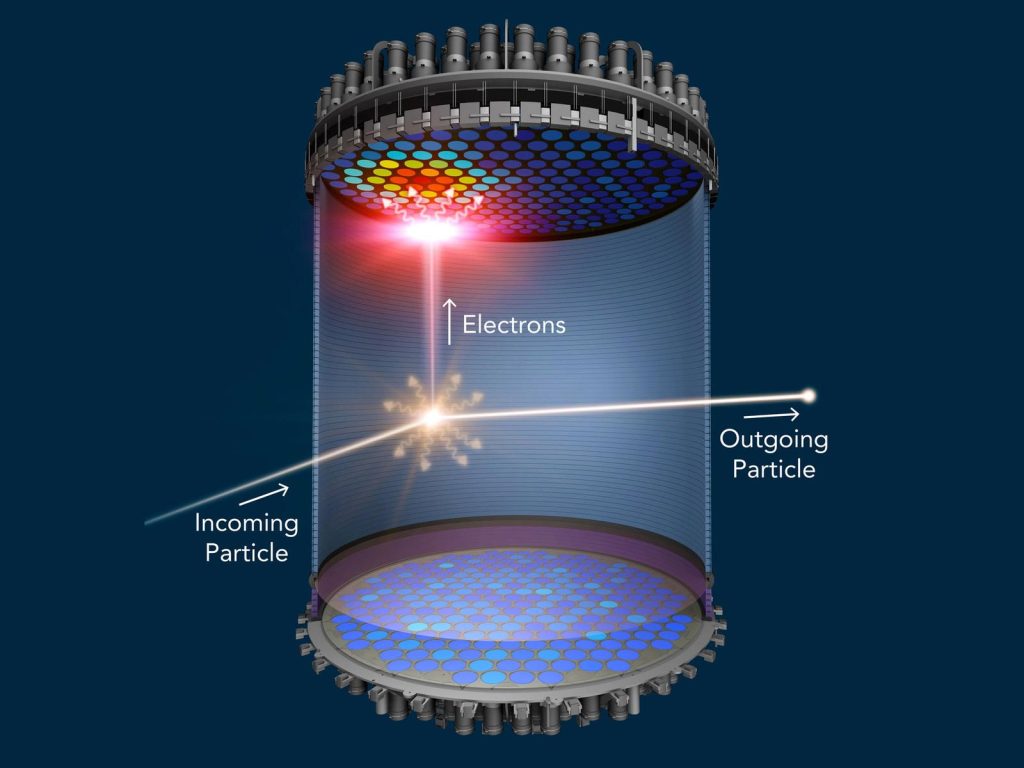

Az LZ csapat tagjai az LZ víztartályban a külső érzékelő felszerelése után. Köszönetnyilvánítás: Matthew Capost, Sanford Underground Research Facility
A Berkeley Lab kutatói sikeresen elindították a LUX-ZEPLIN sötétanyag-detektort a Sanford Underground Research Facility-ben
Innovatív és egyedülállóan érzékeny sötét anyag detektor Luxe Zeppelin (LZ) Kísérlet – túljutott az indítási folyamatok kijelentkezési szakaszán, és megadta az első eredményeket. LZ Dél-Dakotában, a Black Hills mélyén található Sanford Underground Research Facility (SURF), és az Energiaügyi Minisztérium Lawrence Berkeley Nemzeti Laboratóriuma (Berkeley Laboratory) vezeti.
„Készen állunk, és minden jól néz ki” – mondta a Berkeley Lab vezető fizikusa és az LZ korábbi szóvivője, Kevin Lesko. „Ez egy összetett detektor, sok alkatrészből, és mindegyik jól működik az elvárásoknak megfelelően” – mondta.
A kísérletről július 7-én megjelent cikkben weboldalAz LZ tudósai arról számoltak be, hogy a kezdeti működéssel az LZ már a világ legérzékenyebb sötétanyag-érzékelőjévé vált. A papír egy későbbi időpontban jelenik meg az arXiv.org online nyomtatás előtti archívumában. Az LZ szóvivője, Hugh Lippincott, a Santa Barbarai Kaliforniai Egyetemről azt mondta: „Az elkövetkező években körülbelül 20-szor annyi adatot tervezünk gyűjteni, tehát még csak most kezdjük. Rengeteg tudomány van még hátra, ami nagyon izgalmas !”

Kutassa fel az LZ Outer Detectort, amelyet a radioaktivitás megvétózására használnak, amely képes szimulálni a sötét anyag jelét. Köszönetnyilvánítás: Matthew Capost/Sanford Underground Research Facility
Míg sötét anyag A részecskéket valójában nem észlelik, előfordulhat, hogy nem sokáig igazak. A visszaszámlálás már elkezdődött az LZ élő tesztelésének első 60 napjának eredményeivel. Ezeket az adatokat a december végétől kezdődő kezdeti működés három és fél hónapja alatt gyűjtötték össze. Ez elég hosszú volt ahhoz, hogy megbizonyosodjon arról, hogy az érzékelő minden oldala megfelelően működik.
Bár láthatatlan, mivel nem bocsát ki, nem nyel el vagy szór fényt, a sötét anyag létezése és a gravitációs vonzás mégis alapvető fontosságúak az univerzum megértésében. Például a sötét anyag jelenléte, amely a becslések szerint az univerzum teljes tömegének mintegy 85 százalékát teszi ki, alakítja a galaxisok alakját és mozgását, és a kutatók erre hivatkoznak, hogy megmagyarázzák a nagyméretű szerkezetről ismerteket. és kiterjeszti az univerzumot.
Két, tíz tonna ultratiszta folyékony xenonnal megtöltött, egymásba ágyazott titántartályt két sor fotosokszorozó cső (PMT) segítségével lehet megtekinteni, amelyek képesek érzékelni az LZ sötétanyag-detektor magjából érkező halvány fényforrásokat. A titántartályok egy nagyobb detektorrendszerben helyezkednek el, hogy befogják a sötét anyag jelét utánzó részecskéket.
„Örömmel látom, hogy ez az összetett detektor készen áll arra, hogy foglalkozzon azzal a régóta fennálló kérdéssel, hogy miből áll a sötét anyag” – mondta Natalie Palanque Delabruille, a Berkeley Lab Fizikai Tanszékének igazgatója. „Az LZ csapatának most van a legambiciózusabb eszköze ehhez!”
A LUX-ZEPLIN detektor tervezési, gyártási és telepítési fázisait a Berkeley Lab projektmenedzsere, Gil Gilchriese vezette az Egyesült Államok, az Egyesült Királyság, Portugália és Dél-Korea több mint 35 intézményéből származó 250 tudósból és mérnökből álló nemzetközi csapattal együttműködve. Simon Fiorucci, az LZ műveleti igazgatója, a Berkeley Lab-tól. Együtt azt remélik, hogy a műszerrel rögzíthetik a sötét anyag vagy az úgynevezett hiányzó tömeg első közvetlen bizonyítékát az univerzumban.
Henrique Araujo, tól[{” attribute=””>Imperial College London, leads the UK groups and previously the last phase of the UK-based ZEPLIN-III program. He worked very closely with the Berkeley team and other colleagues to integrate the international contributions. “We started out with two groups with different outlooks and ended up with a highly tuned orchestra working seamlessly together to deliver a great experiment,” Araújo said.
An underground detector
Tucked away about a mile underground at SURF in Lead, South Dakota, LUX-ZEPLIN is designed to capture dark matter in the form of weakly interacting massive particles (WIMPs). The experiment is underground to protect it from cosmic radiation at the surface that could drown out dark matter signals.
Particle collisions in the xenon produce visible scintillation or flashes of light, which are recorded by the PMTs, explained Aaron Manalaysay from Berkeley Lab who, as physics coordinator, led the collaboration’s efforts to produce these first physics results. “The collaboration worked well together to calibrate and to understand the detector response,” Manalaysay said. “Considering we just turned it on a few months ago and during COVID restrictions, it is impressive we have such significant results already.”

When a WIMP – a hypothetical dark matter particle – collides with a xenon atom, the xenon atom emits a flash of light (gold) and electrons. The flash of light is detected at the top and bottom of the liquid xenon chamber. An electric field pushes the electrons to the top of the chamber, where they generate a second flash of light (red). LZ will be searching for a particular sequence of flashes that cannot be due to anything other than WIMPs. Credit: LZ/SLAC
The collisions will also knock electrons off xenon atoms, sending them to drift to the top of the chamber under an applied electric field where they produce another flash permitting spatial event reconstruction. The characteristics of the scintillation help determine the types of particles interacting in the xenon.
The South Dakota Science and Technology Authority, which manages SURF through a cooperative agreement with the U.S. Department of Energy, secured 80 percent of the xenon in LZ. Funding came from the South Dakota Governor’s office, the South Dakota Community Foundation, the South Dakota State University Foundation, and the University of South Dakota Foundation.
Mike Headley, executive director of SURF Lab, said, “The entire SURF team congratulates the LZ Collaboration in reaching this major milestone. The LZ team has been a wonderful partner and we’re proud to host them at SURF.”

Chemists at Brookhaven Lab used this custom-made vacuum distillation system to purify linear alkyl benzene needed to produce liquid scintillator for the LZ dark matter experiment. Credit: Brookhaven Lab
Fiorucci said the onsite team deserves special praise at this startup milestone, given that the detector was transported underground late in 2019, just before the onset of the COVID-19 pandemic. He said with travel severely restricted, only a few LZ scientists could make the trip to help on site. The team in South Dakota took excellent care of LZ.
“I’d like to second the praise for the team at SURF and would also like to express gratitude to the large number of people who provided remote support throughout the construction, commissioning and operations of LZ, many of whom worked full time from their home institutions making sure the experiment would be a success and continue to do so now,” said Tomasz Biesiadzinski of SLAC, the LZ detector operations manager.
“Lots of subsystems started to come together as we started taking data for detector commissioning, calibrations and science running. Turning on a new experiment is challenging, but we have a great LZ team that worked closely together to get us through the early stages of understanding our detector,” said David Woodward from Pennsylvania State University who coordinates the detector run planning.

The LZ central detector in the clean room at Sanford Underground Research Facility after assembly, before beginning its journey underground. Credit: Matthew Kapust, Sanford Underground Research Facility
Maria Elena Monzani of SLAC, the Deputy Operations Manager for Computing and Software, said “We had amazing scientists and software developers throughout the collaboration, who tirelessly supported data movement, data processing, and simulations, allowing for a flawless commissioning of the detector. The support of NERSC [National Energy Research Scientific Computing Center] Felbecsülhetetlen értékű volt.”
Lesko szerint az LZ és rendszerei sikeres működésének megerősítése mellett ideje elkezdeni a nagyszabású megfigyeléseket abban a reményben, hogy egy sötét anyag részecske ütközik xenonnal.[{” attribute=””>atom in the LZ detector very soon.
LZ is supported by the U.S. Department of Energy, Office of Science, Office of High Energy Physics and the National Energy Research Scientific Computing Center, a DOE Office of Science user facility. LZ is also supported by the Science & Technology Facilities Council of the United Kingdom; the Portuguese Foundation for Science and Technology; and the Institute for Basic Science, Korea. Over 35 institutions of higher education and advanced research provided support to LZ. The LZ collaboration acknowledges the assistance of the Sanford Underground Research Facility.

„Utazási specialista. Tipikus közösségi média tudós. Az állatok barátja mindenhol. Szabadúszó zombinindzsa. Twitter-barát.”






More Stories
A SpaceX Polaris Dawn űrszondájának legénysége a valaha volt legveszélyesebb űrsétára készül
Egy őskori tengeri tehenet evett meg egy krokodil és egy cápa a kövületek szerint
Egyforma dinoszaurusz-lábnyomokat fedeztek fel két kontinensen